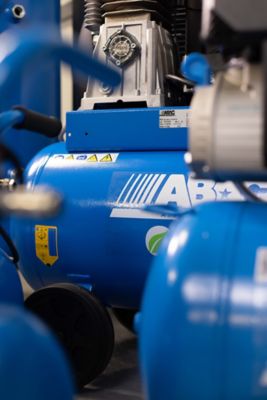Free Air Delivery (FAD) is the actual volume of air delivered by the compressor, measured at the outlet under specific conditions. It is an important factor to consider when choosing an air compressor because it indicates the compressor's efficiency and performance. FAD is typically expressed in liters per minute (l/min) or cubic feet per minute (CFM). A higher FAD value means the compressor can deliver more air, which is essential for applications requiring a continuous and reliable air supply
How to Select Air Compressor?
Explore ABAC Air Compressor Sizes Chart, Applications and CFM/PSI Requirements
Welcome to our guide for buying an air compressor! Whether you're a DIY enthusiast or a seasoned industrial professional, choosing the right air compressor can be a daunting task. With so many options available, it's easy to feel overwhelmed.
But don't worry, we're here to help you navigate through the complexities and make an informed decision. In this guide, we'll cover everything from air compressor sizes to noise levels, ensuring you have all the information you need to make the best choice.
What Type of Air Compressor Do I Need?
Home vs. Industrial Air Compressors
One of the first questions you should ask yourself is whether you need an air compressor for home use or industrial applications. The requirements for these two scenarios can be vastly different.
Home Use
For home use, air compressors are generally smaller, more portable, and less powerful. They are perfect for tasks like inflating tires, powering small air tools, and even spray painting. These compressors usually operate on a single-phase power supply and are designed to be user-friendly.
Industrial Use
Industrial air compressors, on the other hand, are built for heavy-duty applications. They are larger, more powerful, and can handle continuous operation. These compressors often require a three-phase power supply and are designed to meet the high demands of industrial environments. They are ideal for powering large machinery, pneumatic tools, and other industrial equipment.
Matching Electrical Supply
Matching the electrical supply to your air compressor is crucial for safe and efficient operation. Here's what you need to consider:
Single-Phase Power Supply
If you're using a single-phase power supply, your options are somewhat limited. Single-phase power can typically support compressors with up to 3 HP (2.2 KW). These compressors are suitable for most home and light industrial applications.
Three-Phase Power Supply
For more demanding applications, a three-phase power supply is essential. Three-phase power can support compressors with higher horsepower, making them ideal for industrial use. Ensure that your facility's electrical infrastructure can handle the power requirements of the compressor you choose.
Choosing the Right Compressor Size
Choosing the right air compressor size is crucial for ensuring efficient and effective operation. Here's what you need to consider:
Airflow is measured in liters per minute (l/min) or cubic feet per minute (CFM), and pressure is measured in bar or pounds per square inch (PSI). Different tools and applications require specific l/min and bar levels. For example, spray painting typically requires a compressor that can deliver steady airflow at a relatively low pressure.
Capacity refers to the maximum amount of free air a compressor can produce at a specified RPM, while flow rate refers to the volume of air that is being delivered per unit of time. Both are crucial for ensuring a compressor can handle the demands of your tools and applications.
Will the compressor be used for high-pressure work? High-pressure applications require robust compressors capable of handling greater demands.
The most accurate way to determine the total flow required is to conduct a compressed air audit performed by a compressed air sales professional. This will help you choose the right size and type of compressor for your needs.
Considerations for Specific Needs
Several additional factors can impact your choice of air compressor. These details address some of these specific considerations.
Do you have the appropriate electrical system to support the compressor? Consider whether your existing electrical infrastructure can support the power requirements of your chosen compressor.
Where will the compressor be used? Is a silenced model necessary? Identify whether noise reduction is a priority in your environment and select accordingly.
Is the purity of the compressed air critical for your operations? Applications such as food and beverage processing, electronics manufacturing, and pharmaceuticals often require highly purified air.
Is it possible to install the compressor away from the point of use of the compressed air? Consider whether remote installation could benefit your setup, reducing noise or freeing more workspace.
Is your application remote? Consider a petrol or diesel driven compressor. Unplug your problems with an ABAC engine driven compressor.
How much compressed air do you need for your operations? Ensuring that the compressor's capacity meets your demand is essential for efficient operation.
Which tools will be connected to the compressor? Different tools have varying air requirements; ensuring compatibility with your compressor is crucial.
Understanding Air Compressor Capacity and Flow Rate
What is the right air flow for my compressor?
The right air flow depends on the tools and applications you intend to use. Calculate the combined CFM of your connected tools to determine the required airflow.
What amount of pressure do I need?
PSI requirements vary by tool and application. Ensure your selected compressor can deliver the necessary pressure for efficient operation.
Applications and l/min, CFM, bar and PSI Requirements
Each application will have specific CFM and PSI requirements. Here are some common scenarios:
| Applications | CFM | l/min | bar | PSI |
|---|---|---|---|---|
| Home use | 1-2 | 28-56 | 5-6 | 70-90 |
| Spray Gun | 4-8 | 113-226 | 2-3.5 | 30-50 |
| Spray Painting | 4-8 | 113-226 |
2-3.5 | 30-50 |
| Sandblasting | 6-25 | 170-700 | 5-6 | 70-90 |
| Various Power Tools | 3-10 | 85-280 | 6-8 | 90-120 |
| HVAC Systems | 6-12 | 170-340 | 5.5-7 | 80-100 |
| Refrigeration | 3-5 | 85-141 | 4-5.5 | 60-80 |
| Automotive Assembly | 8-15 | 226-425 | 6-8 | 90-120 |
| Food and Beverage Packaging | 4-10 | 113-280 | 5-6 | 70-90 |
| Air tools | CFM | l/min | bar | PSI |
|---|---|---|---|---|
| Airbrush | 0.5-1.5 | 14-42 | 1.5-2 | 20-30 |
| Nail Gun | 1-2 | 28-56 | 5-6 | 70-90 |
| Dental Equipment | 2-4 | 56-113 | 5.5-7 | 80-100 |
| Tyre Inflator | 2-3 | 56-85 | 7-10 | 100-150 |
| Impact Wrench | 3-5 | 85-141 | 6-7 | 90-100 |
| Air Ratchet | 3-5 | 85-141 | 6-7 | 90-100 |
| Hammer Drill | 3-6 | 85-170 | 6-8 | 90-120 |
| Paint Sprayer | 6-7 | 170-200 | 2-3.5 | 30-50 |
| Grinder | 5-8 | 141-226 | 6-8 | 90-120 |
Types of Air Compressors
Air compressors come in various types, each suited for different applications. Two common types are reciprocating (piston) compressors and rotary screw compressors.
Reciprocating (Piston) Compressors
Reciprocating compressors, also known as piston compressors, use pistons driven by a crankshaft to deliver air at high pressure. These compressors are typically used for applications requiring high pressure and lower volumes of air. They are known for their durability and ability to handle intermittent duty cycles, making them ideal for smaller operations and workshops.
Rotary Screw Compressors
Rotary screw compressors use two interlocking helical screws (rotors) to compress air. As the screws rotate, they reduce the volume of the air, increasing its pressure. These compressors are designed for continuous operation and are commonly used in industrial applications requiring a constant supply of compressed air. They are known for their efficiency, reliability, and low maintenance requirements.
Silenced Compressors
Silenced compressors are designed to provide powerful performance while maintaining a quiet operation. These compressors are ideal for environments where noise reduction is crucial, such as workshops, garages, and home use. With soundproofing technology and canopy, they ensure minimal disruption without compromising on efficiency.
Oil Free vs. Oil-Injected Compressors
Choosing between oil-free and oil-injected compressors depends on your specific application needs.
Oil-Free Compressors
Oil free compressors have no oil contamination in the compressed air stream. They are suitable for applications where oil contamination is unacceptable, such as food and beverage, medical and pharmaceuticals.
Lubricated Compressors
Lubricated compressors mix lubricant with compressed air. They are generally more durable and can handle more demanding applications. However, they require additional filtration to remove oil from the compressed air.
Energy Transmission in Air Compressors
Belt-Driven Compressors
Belt-driven compressors have a motor that is connected via a belt to the pumping unit. These compressors are generally more affordable and easier to maintain.
Advantages:
- Cost-effective solution
- Simple maintenance, ideal for small to medium operations
- Flexible operation, suitable for a variety of applications
Direct Driven Compressors
Direct driven compressors have no intermediate element between the motor and the pumping unit, resulting in more compact designs, less maintenance, and higher efficiency.
Advantages:
- High efficiency, minimising energy loss
- Low maintenance, reducing operational downtime
- Compact design, ideal for tight spaces













